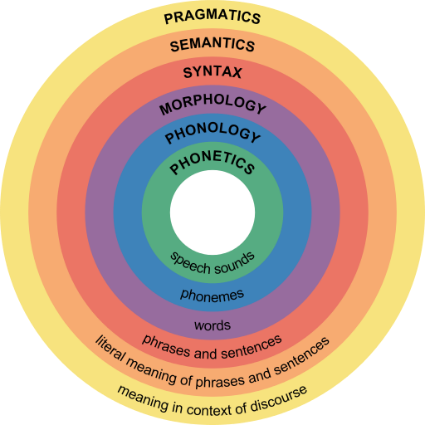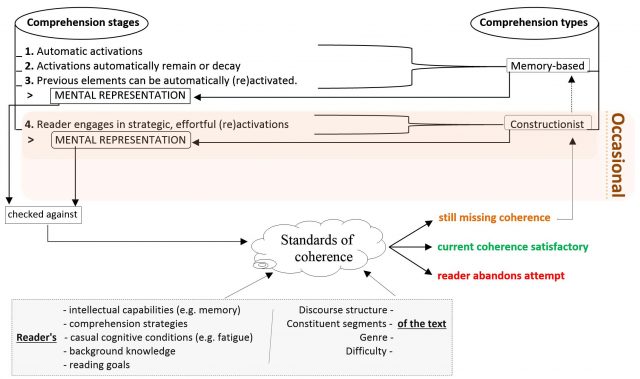Language, semantics and discourse: into the Landscape Model of reading
Researchers seem to be reassured and perhaps compete in remarking the complexity of their own topics of study. We language scientists, however, can sit back and let our topic do the talking. Phonetics, phonology, morphology, syntax, semantics, and pragmatics are, broadly, the super-cogs in the language machinery, each recruiting a set of brain systems in turn (see also Miller, 19911; Fromkin & Rodman, 1974 2). These levels are relatively sequential, such that phonetic decoding will precede any phonological decoding, and so on (note that these levels are not fixed, and most often they are customized to particular research foci). In this article, we will pierce into the semantic level, namely the forge of meaning. Indeed, semantics refers to the integration of textual and extra-textual information relevant to a given message, often known as ‘discourse.’

In part due to experimental practicality, most research on semantics has been based on written text. So too in this review we will focus on reading data. Through the 1990s, two opposing theories on discourse understanding prevailed: the memory-based theory and the constructionist theory.
In the memory-basedapproach, reading was construed as autonomous, unconscious and effortless. Thus, the activations needed to connect text elements and understand the textual whole—the discourse—would be facilitated via pre-existing associations from the text as well as from background knowledge of the reader (e.g., O’Brien, Albrecht, Hakala, & Rizzella, 1995 3; Myers, & O’Brien, 1998 4; O’Brien, & Myers, 1999 5). Arguably, the major pitfall of this account would be the potential loss of track in reading, which can ail even the most skilled of readers. If there are no conscious (re)activations, how could we regain the lead? This would be most problematic with texts like the present, where a specialized topic is conveyed through long, complex sentences.
Opposing the memory-based theory, there was the constructionist theory. On this view, the activation of text elements was conscious and even strategic. Indeed, all activations would arise out of a time-consuming effort, with readers accessing prior text and/or personal knowledge to co-construct the current text (e.g. Graesser, Singer, & Trabasso, 1994 6; Singer, Graesser, & Trabasso, 1994 7). Now, a posteriori, with further accounts at hand, one can readily point out the drawbacks in this account, as with the previous one. How pleasurable would leisure reading be in the midst of such an effortful machinery? Would this activity become as accelerated as it often becomes, were readers supposed to consciously compute every textual association?
In 1999, a new account of reading comprehension was presented under the name of Landscape Model (LM) (van den Broek, Young, Zheng & Linderholm, 1999 8). LM came to bridge the previous accounts with the introduction of two crucial constraints: firstly a central of sense through which all potential representations must be run, and secondly a conditional step of conscious analysis for situations of complex discourse. I have tried to illustrate this holistic model graphically, as based on Yeari and van den Broek (2011) 9. A given representational attempt will start at stage number 1. From there, 1 to 3 are engaged sequentially for every representation, while 4 is only relevant occasionally.

Mark the content feeding the standards of coherence. There is, on the one hand, the reader’s personal and linguistic experience, and, on the other hand, content from the text at hand. Now, the specific importance of each of the constraints—cognitive resources, purpose, discourse structure…—is unfledged, and it is likely to remain so because measuring those weights might be asking too much from our statistical tools. Nevertheless, those constraints seem sensible, and in line with other research on language comprehension. Indeed, studies have suggested that different conceptual systems – i.e. symbolic and embodied – are dependent on factors similar to those posited in LM, i.e. task and stimulus (Louwerse and Connell, 2011 10; Lebois, Wilson-Mendenhall, & Barsalou, 2014 11).
To end, let us touch upon a practical application of this model, noted in Yeari & van den Broek (2011). Ordinarily, reading comprehension unfolds in increments, with the reader initially focusing on smaller units such as words and phrases, then accessing the higher discourse structure of the text, to eventually reach out for a general sense—which will remain longest and the most strongly in memory. That is the most natural route and occurs automatically. In contrast, scrutinizing a text demands an unusual attention that extends ‘beyond the automatic, memory-based processes that also take place’ (p. 639). The authors conclude by advising discourse analysts to adopt a top-down approach in their task, conducting a broad scan prior to any linguistic scrutiny (see also Bell, 201112).
References
- Miller, G. A. (1991). The Science of Words. New York: Scientific American Library. ↩
- Fromkin, V., & Rodman, R. (1974). An introduction to language. New York, NY: Holt, Rinehart and Winston. ↩
- O’Brien, E. J., Albrecht, J. E., Hakala, C. M., & Rizzella, M. L. (1995). Activation and suppression of antecedents during reinstatement. Journal of Experimental Psychology: Learning, Memory, and Cognition, 21, 626–634. ↩
- Myers, J. L., & O’Brien, E. J. (1998). Accessing the discourse representation during reading. Discourse Processes, 26, 131–157. ↩
- O’Brien, E. J. & Myers, J. L. (1999). Text comprehension: A view from the bottom up. In S. R. Goldman, A. C. Graesser, and P. van den Broek (Eds.), Narrative Comprehension, Causality, and Coherence: Essays in Honor of Tom Trabasso (pp. 35-53). Mahwah, NJ: Lawrence Erlbaum Associates. ↩
- Graesser, A., Singer, M., & Trabasso, T. (1994). Constructing inferences during narrative comprehension. Psychological Review, 101, 371–395. ↩
- Singer, M., Graesser, A. C., & Trabasso, T. (1994). Minimal or global inference during reading. Journal of Memory and Language, 33, 421–441. ↩
- Van den Broek, P., Young, M., Tzeng, Y., & Linderholm, T. (1999). The landscape model of reading. In H. van Oostendorp & S. R. Goldman (Eds.), The construction of mental representations during reading (pp. 71-98). Mahwah, NJ: Erlbaum. ↩
- Yeari, M., & van den Broek, P. (2011). A cognitive account of discourse understanding and discourse interpretation: The Landscape Model of reading. Discourse Studies, 13, 5, 635-643. ↩
- Louwerse, M., & Connell, L. (2011). A taste of words: linguistic context and perceptual simulation predict the modality of words. Cognitive Science, 35, 2, 381-98. ↩
- Lebois, L. A. M., & Wilson-Mendenhall, C. D., & Barsalou, L. W. (2014). Are automatic conceptual cores the gold standard of semantic processing? The context-dependence of spatial meaning in grounded congruency effects. Cognitive Science. ↩
- Bell, A. (2011). Re-constructing Babel: Discourse analysis, hermeneutics and the Interpretive Arc. Discourse Studies, 13, 5, 519-568. ↩
2 comments
[…] ¿Cómo leemos? La pregunta, así, a bote pronto, puede parecer un poco rara, pero la respuesta no es tan evidente. De hecho existen varios modelos teóricos que explican cómo leemos. Pablo Bernabéu nos hace una breve introducción a ellos […]
[…] ¿Cómo leemos? La pregunta, así, a bote pronto, puede parecer un poco rara, pero la respuesta no es tan evidente. De hecho existen varios modelos teóricos que explican cómo leemos. Pablo Bernabéu nos hace una breve introducción a ellos […]